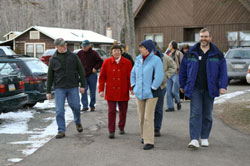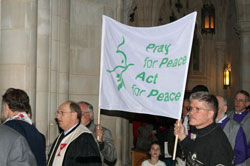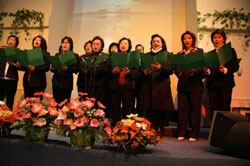Ok, here’s some good bedtime reading: Organizational trends through the eyes of an ecclesiacrat (wake me when it’s over, right?). Seriously though, the following is adapted from the first part of my final “State of the Conference†report to the Franconia Conference Board retreat that met January 29, 2007. For blog readers unaware of why this is my final report, my 14-year role as conference executive for Franconia Mennonite Conference ends this August.
Macro Trends throughout MC USA and Beyond
 1. The classic 20th-century “Liberal – Conservative†continuum/dichotomy is being replaced with an “Established – Emergent†continuum/dichotomy. Diana Butler-Bass pictures the former continuum running horizontally, and the latter one running vertically. From my perspective this shift begins replacing the primary values/measures of historical theology and geography/proximity with effectiveness, relevance and organizational alignment as primary measures of affiliation.
1. The classic 20th-century “Liberal – Conservative†continuum/dichotomy is being replaced with an “Established – Emergent†continuum/dichotomy. Diana Butler-Bass pictures the former continuum running horizontally, and the latter one running vertically. From my perspective this shift begins replacing the primary values/measures of historical theology and geography/proximity with effectiveness, relevance and organizational alignment as primary measures of affiliation.
Like each of the five trends listed here, I’m reporting what I see/hear, and not what I like or dislike. There are parts of these trends—this one for example—that frankly scare me. But I’m aware that they are trends because they are based on larger, complex patterns in our society and world. What is your response to reading this one?
 2. There is broad acknowledgement that current organizational assumptions—that are still largely based on 19th-century models focused on “control†and the implied assumption of “steady state†in a changing world—cannot handle 21st-century complexity and rate of change (with its need for quicker decision-making, prioritizing, partnering, etc.) along with the 21st-century corollary values focused on influence, transformation and authenticity. Much of the church’s structures are currently based around multiple specializations more than on collaboration toward one clear purpose. Interpersonal disputes and leadership challenges that turn personal are usually based on resulting matters of misalignment or inability to achieve organizational integration.
2. There is broad acknowledgement that current organizational assumptions—that are still largely based on 19th-century models focused on “control†and the implied assumption of “steady state†in a changing world—cannot handle 21st-century complexity and rate of change (with its need for quicker decision-making, prioritizing, partnering, etc.) along with the 21st-century corollary values focused on influence, transformation and authenticity. Much of the church’s structures are currently based around multiple specializations more than on collaboration toward one clear purpose. Interpersonal disputes and leadership challenges that turn personal are usually based on resulting matters of misalignment or inability to achieve organizational integration.
Simply stated, our models in the church in most of the 20th century were based on earlier values and assumptions. Few leaders today would expect today’s congregation can plan—in any detailed way—20 years out. Admit it; in 1987 you didn’t see the Internet coming. Yet today’s leaders can help the congregation discern and focus the one main thing that God is calling that congregation to do and be in their context. It’s much less confusing to adapt to change when you know your place under the sun.
 3. Related to number 2, there is a growing momentum for a holistic missional church vision that is fairly quickly replacing interest in the long-standing programmatic, silo-oriented structures. While this cognitive shift gains momentum, actually getting to this new place (organizationally and behaviorally) will continue to cause pain and hurt within congregations and other systems as folks sort through what to keep from the past and what to permit in the future. The best medicine is strong, honest, vulnerable, flexible, differentiated leadership and healthy processes that help the grass roots own the process along the way. Focusing on “change†(cognitive, rational) precedes but is not the same as “transition†(visceral, behavioral), which takes longer and is always harder.
3. Related to number 2, there is a growing momentum for a holistic missional church vision that is fairly quickly replacing interest in the long-standing programmatic, silo-oriented structures. While this cognitive shift gains momentum, actually getting to this new place (organizationally and behaviorally) will continue to cause pain and hurt within congregations and other systems as folks sort through what to keep from the past and what to permit in the future. The best medicine is strong, honest, vulnerable, flexible, differentiated leadership and healthy processes that help the grass roots own the process along the way. Focusing on “change†(cognitive, rational) precedes but is not the same as “transition†(visceral, behavioral), which takes longer and is always harder.
If you are allergic to the word “missional,†feel free to ignore it. All is really means is: Aligning our efforts with God’s redeeming activity in the world. For a great resource on the difference between change and transition, check out William Bridges’ book Managing Transitions: Making the Most of Change
 4. The role of the church will continue to move from the meetinghouse to the marketplace. Inquiring Anabaptists find there is a growing (and in some circles an almost popular) appetite for Christ’s Gospel of peace and a legacy of competence for practical peacemaking in a shrinking global village. Just as vast constituencies value Catholics for their deep heritage of discernment and education, Mennonites would do well to focus on the palpable interest in Anabaptist values. Sadly, this seems to be happening at a time when more than a few Anabaptist groups are struggling over their continuing efforts to live out the notions of community, mutual aid and nonviolence at a daily level (how we run our businesses, how we drive our cars, relationships with neighbors, etc.).
4. The role of the church will continue to move from the meetinghouse to the marketplace. Inquiring Anabaptists find there is a growing (and in some circles an almost popular) appetite for Christ’s Gospel of peace and a legacy of competence for practical peacemaking in a shrinking global village. Just as vast constituencies value Catholics for their deep heritage of discernment and education, Mennonites would do well to focus on the palpable interest in Anabaptist values. Sadly, this seems to be happening at a time when more than a few Anabaptist groups are struggling over their continuing efforts to live out the notions of community, mutual aid and nonviolence at a daily level (how we run our businesses, how we drive our cars, relationships with neighbors, etc.).
At this point you either like what I’ve shared or really can’t stand the thought of reading the fifth and final trend. But from my half-time role as FMC conference executive, and my other half-time role as an organizational consultant and coach across the U.S., I’m just reporting here what I keep hearing and seeing. Does this match what you hear and see?
 5. Measurements from the past centuries—including church membership, ordination, and clear organizational boundaries—will continue to become less important and relevant; while new measurements will become increasingly important in a world in which individuals and informal networks can hold businesses and even countries hostage, and unknown start-ups like Google and YouTube can go from 0 to 60 almost overnight and influence global markets. Existing measurements will still play a role to be sure, but new measurements are needed immediately, including measurements that can track with the shifting values named in these above five trends.
5. Measurements from the past centuries—including church membership, ordination, and clear organizational boundaries—will continue to become less important and relevant; while new measurements will become increasingly important in a world in which individuals and informal networks can hold businesses and even countries hostage, and unknown start-ups like Google and YouTube can go from 0 to 60 almost overnight and influence global markets. Existing measurements will still play a role to be sure, but new measurements are needed immediately, including measurements that can track with the shifting values named in these above five trends.
If you find yourself rejecting this trend, reflect on the long-standing measures of the recent past as compared with ancient ones—the modern church’s measures with those of the early church. Like I said—which I’ll repeat so this is reporting and not heresy—current measures will be useful for now, but we also need to be open to new measures (or ones that once again tap into the early church’s values). Jesus focused on discipling people, empowering leaders, and building relationships wherever he went. The church later added measures. Along the way the church changed the measures it needed. We can do it again and be faithful in reclaiming the values modeled by Jesus Christ.
In my next blog entry I’ll drill down from these macro trends to ones specifically within the Franconia Mennonite Conference. Bet some of you can’t wait…
The opinions expressed in articles posted on Mosaic’s website are those of the author and may not reflect the official policy of Mosaic Conference. Mosaic is a large conference, crossing ethnicities, geographies, generations, theologies, and politics. Each person can only speak for themselves; no one can represent “the conference.” May God give us the grace to hear what the Spirit is speaking to us through people with whom we disagree and the humility and courage to love one another even when those disagreements can’t be bridged.

Phil, thanks for this blog. These are good observations, and true I think. But they’re couched in a lot of difficult language. I think I have a fairly advanced vocabulary, but I struggle to mentally process terms like “measures of affiliation” and “silo-oriented”. I’m one of those looking forward to your next blog; I’m always interested in bringing abstract concepts home to our own situation. Maybe just try to simplify the language a bit more if possible. Thanks also for your many years of positive leadership in Franconia Conference. My generation is now and will reap benefits from your service.
Blessings,
Forrest
These are good and interesting comments that confirm much of what I see in my work at the Alban Institute. As one of Diana Butler Bass’s publishers (as well as her husband), I’d be interested to hear you say more about what scares about your first point. I’d suggest that she isn’t replacing the horizontal continuum with another, but bringing to our awareness the existence of the vertical continuum (which she labels established-intentional) and the influence it has on both the horizontal continuum and on our theology/ecclesiology. She’s complexifying the current situation and suggesting that seeing everything in left-right terms is probably not helpful. I do find her work much more rooted in historical theology than in organizational development and, like many of her readers, find it hopeful and encouraging.
You do have a point about proximity. As you make clear in your fourth point, the hunger of people is not always met by the proximate congregation and so people look for food where they will be fed.
Peace.
Forrest Moyer, thanks for your feedback. Sorry about the words. I’ll try to improve on the second installment. Phil
Richard Bass, thanks for this clarification of Diana Butler Bass’s thoughts and writing. I heard her at the Ecumenical Stewardship Center’s Leadership Seminary in Florida in late November and appreciated her perspective. Thanks for sharpening that Diana is actually complexifying things and not simply replacing one continuum with another. Phil
To Richard Bass’s interest in hearing more about what scares me in the first point: I’m not assuming this is what Diana said/is saying, but my concerns on this first point pertain to the observation that we are moving into a “cut flower” point of reference. Being cut off from a sense of rootedness is a significant challenge for today’s/tomorrow’s church. Just doing what’s effective will have a short life. Historically Mennonites have not had a theology apart from history, so this is a significant shift.
Thanks for this outline of Big Issues affecting the church, Phil. At Associated Mennonite Biblical Seminary we are attempting this spring to define such megatrends, with a view toward how these might shape theological/pastoral formation in the generation ahead. Your list is provocative and helpful–although still abstract enough that it’s hard to think through institutional implications for a seminary. Press on, though– you’re doing important work for the church.
Thanks Nelson. I’m very willing to take this conversation to a more tangible level. I’ll be in touch with you privately to learn what would be helpful. –Phil